#21 March 1957
Explore tagged Tumblr posts
Text






























On March 21, 1957, the name was officially changed from White Horse to Whitehorse.
#Whitehorse#Yukon#the North#travel#original photography#vacation#tourist attraction#landmark#cityscape#architecture#sculpture#summer 2023#Building on the Past Looking to the Future by Ken Anderson#Healing Totem#MacBride Museum of Yukon History#Government Telegraph Office#21 March 1957#name changed#anniversary#Canadian history#Yukon River#Miles Canyon#Schwatka Lake#First Nations#Canada
1 note
·
View note
Text


















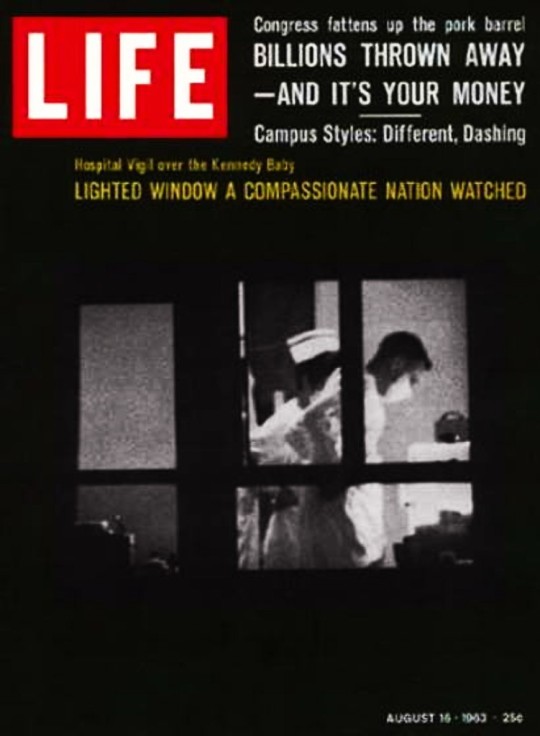

The Kennedys' on LIFE magazine (Part 1/3)
"Senator Goes A-Courting" (John F. Kennedy & Jacqueline Bouvier), July 20, 1953.
"Author Kennedy" (John F. Kennedy), March 11, 1957.
"Jacqueline, Caroline and Jack Kennedy", April 21, 1958.
"Jackie Kennedy A Front Runner's Appealing Wife" (Jackie & John F. Kennedy), August 24, 1959.
"Hubert And Jack In Wisconsin" (John F. Kennedy), March 28, 1960.
"The Victorious Young Kennedys" (Rose Kennedy, Jackie Kennedy, John F. Kennedy and Jean Kennedy Smith), November 21, 1960.
"The Kennedys And Their Son At Christening" (John F. Kennedy, Jackie Kennedy & John F. Kennedy Jr,), December 19, 1960.
"The Kennedy Inauguration" (John F. Kennedy & Jackie Kennedy), January 27, 1961.
"The Kennedys In Canada" (Jackie Kennedy), May 26, 1961.
"Kennedy In Paris" (John F. Kennedy), June 9, 1961.
"Any dangerous spot is tenable if brave men will make it so" (John F. Kennedy), August 4, 1961.
"The First Lady She Tells Her Plans For The White House" (Jackie Kennedy), September 1, 1961.
"Year-old JFK Jr. Plays with Gifts from Charles de Gaulle" (John F. Kennedy Jr.), November 24, 1961.
"Hard-headed, Hard-driving, Kid brother Capital's No.2 man, Bob Kennedy closes in" (Robert F. Kennedy), January 26, 1962.
"The Senate Seat Scramble In Massachusetts; Head on Collison of Three Political Clans: Eddie McCormack, Teddy Kennedy & George Lodge" (Edward M. Kennedy), June 29, 1962.
"Kennedy In Mexico City" (John F. Kennedy), July 13, 1962.
"The Fun Of Being Caroline" (Caroline Kennedy), September 7, 1962.
"Charming Album Of Jackie Growing Up" (Jackie Kennedy), April 26, 1963.
"Hospital Vigil Over Kennedy Baby: Lighted Window A Compassionate Nation Watched", August 16, 1963.
"President John F. Kennedy 1917-1963" (John F. Kennedy), November 29, 1963.
#on the cover#life magazine#the kennedys#john f. kennedy#jfk#jackie kennedy#caroline kennedy#rose kennedy#jean kennedy smith#john f. kennedy jr.#robert f. kennedy#rfk#edward m. kennedy#ted kennedy#1950s#1960s
86 notes
·
View notes
Text
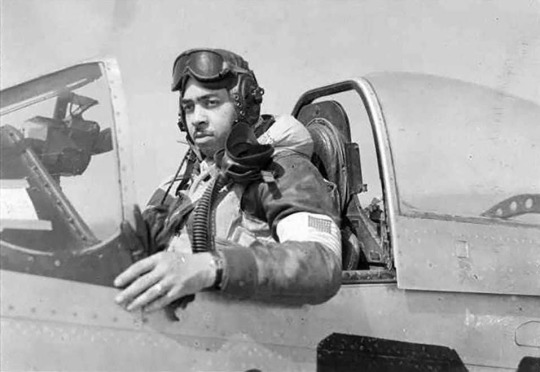
JACK DANIELS HOLSCLAW (1918-1998)
Tuskegee Airman Jack Daniels Holsclaw was born in Spokane, Washington, on March 21, 1918. His father, Charles, was a clerk in a downtown store, and his mother, Nell, was a manager at Pacific Telephone and Telegraph. Holsclaw attended North Central High School in Spokane, where he excelled both academically and athletically. When he was 15, he became the first black person in Spokane to earn the Eagle Scout badge.
Holsclaw entered Whitworth College in 1935 but transferred to Washington State College (now Washington State University) in 1936 to play baseball. Beginning in his junior year, he played center field and helped the Cougars finish as co-champions of the Northern Division, Pacific Coast Conference. He was the second African American earn a varsity letter in baseball at the college.
In 1939, Holsclaw transferred to a chiropractic program at Western States College in Portland, Oregon, where he met his wife, Bernice Williams. They had one son, Glen. Holsclaw completed the chiropractic program in 1942 and passed the Oregon state board examination.
While there, he enrolled in a government sponsored Civilian Pilot Training Program at Multnomah College and earned his pilot’s license. On October 5, 1942, he enlisted in the army as a private and entered flight school, training at Tuskegee Army Airfield, Alabama. After completing his training, he received his wings and was commissioned as a 2nd Lieutenant on July 28, 1943. Lieutenant Holsclaw received advanced training at Selfridge Field near Detroit, Michigan before his squadron was shipped to Italy in December 1943.
Lieutenant Holsclaw flew in the 100th Fighter Squadron, 332d Fighter Group, an all-black pursuit squadron. Holsclaw named his favorite P-51 “Bernice Baby” in honor of his wife. The 332d Fighter Group had distinctive red tails giving them the nickname “Red Tails.” The 332d Fighter Group escorted bombers on their runs over enemy territory, shielding them from German fighters. To the bomber crews that were protected by them they were the “Red Tail Angels.”
On July 18, 1944, in an aerial battle over Italy, Holsclaw shot down two German fighters. For this action he received the Distinguished Flying Cross. By December 1944, Holsclaw had completed 68 combat missions, nearing the limit of 70, when he became Assistant Operations Officer, an important administrative position that included aerial mission planning. In January 1945, Holsclaw was promoted to captain.
Captain Holsclaw returned to the United States in June 1945 to serve as assistant base operations officer at Godman Field, Fort Knox, Kentucky. He served as an Air Force ROTC instructor at Tuskegee Institute and then Tennessee State College.
From 1954 to 1957, Holsclaw was assigned to Japan, and from May 1962 to the end of 1964, he served as chief of the training division, Sixth Air Force Reserve Region at Hamilton Air Force Base, California. He directed the preparation of two textbooks to guide incoming air force personnel. Holsclaw retired from the Air Force on December 31, 1964 as a Lieutenant Colonel.
From 1965 to 1973 Holsclaw served as a manager in the Marin County Housing Authority, California. In 1973, he and Bernice returned to Washington where Holsclaw joined the staff at the People’s National Bank in Bellevue. He remained there until his second retirement in 1983. He and Bernice took up residence in Arizona, where Jack Holsclaw died on April 7, 1998, at the age of 80.
In August 2019, the Jonas Babcock Chapter, NSDAR, dedicated a historical marker in the memory of Lt. Col. Holsclaw at the site of his childhood home in Spokane.
146 notes
·
View notes
Photo

TV Guide - July 4 - 10, 1964
Raymond William Stacy Burr (May 21, 1917 – September 12, 1993) Actor, primarily known for his title roles in the television dramas Perry Mason and Ironside. He was prominently involved in multiple charitable endeavors, such as working on behalf of the United Service Organizations.
Burr emerged as a prolific television character actor in the 1950s. He made his television debut in 1951, appearing in episodes of Stars Over Hollywood, The Bigelow Theatre, Family Theater and the debut episode of Dragnet. He went on to appear in such programs as Gruen Playhouse, Four Star Playhouse, Ford Theatre, Lux Video Theatre, Mr. and Mrs. North, Schlitz Playhouse of Stars and Playhouse 90
Burr moved from CBS to Universal Studios, where he played the title role in the television drama Ironside, which ran on NBC from 1967 to 1975.
After Ironside went off the air, NBC failed in two attempts to launch Burr as the star of a new series. In a two-hour television movie format, Mallory: Circumstantial Evidence aired in February 1976. In 1977, Burr starred in the short-lived TV series Kingston: Confidential. He took on a shorter project next, playing an underworld boss in a six-hour miniseries, 79 Park Avenue.
He won two Emmy Awards, in 1959 and 1961, for the role of Perry Mason, which he played for nine seasons (1957–1966) and reprised in a series of 26 television films (1985–1993). His second TV series, Ironside, earned him six Emmy nominations and two Golden Globe nominations. (Wikipedia)\
Erle Stanley Gardner (July 17, 1889 – March 11, 1970) was an American lawyer and author. He is best known for the Perry Mason series of detective stories, but he wrote numerous other novels and shorter pieces and also a series of nonfiction books, mostly narrations of his travels through Baja California and other regions in Mexico.
The best-selling American author of the 20th century at the time of his death, Gardner also published under numerous pseudonyms, including A.A. Fair, Kyle Corning, Charles M. Green, Carleton Kendrake, Charles J. Kenny, Stephen Caldwell, Les Tillray and Robert Parr. (Wikipedia)
39 notes
·
View notes
Text
"HOT DOG"
"THE DAY ELVIS BLEW HIS TOP!"
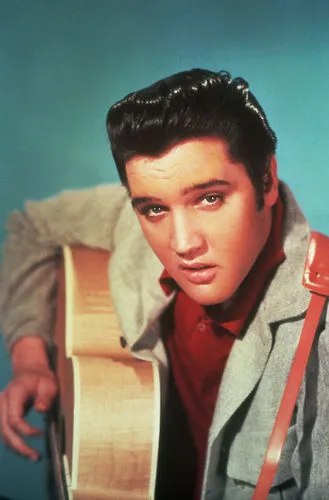
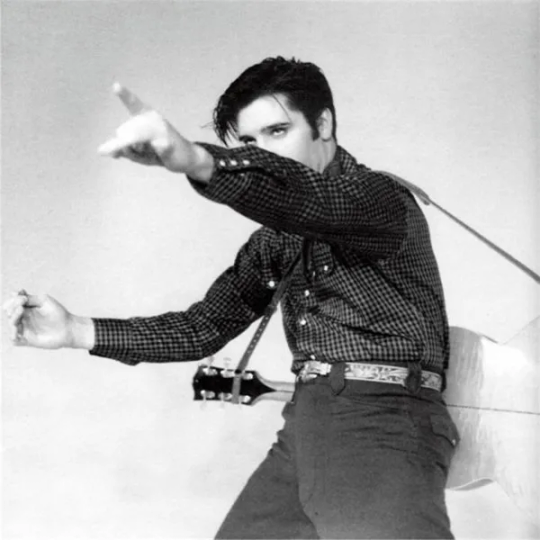
Elvis' photo shoot for "Loving You" (Paramount 1957)
youtube
Elvis Presley: Loving You album, released in June 1957
Written by Jerry Leiber and Mike Stoller for Elvis' second movie score, "Hot Dog" was recorded at the Paramount Scoring Stage on mid-January 1957. According to Ernst Jorgensen in "Elvis Presley: A Life In Music", the song "lasted all of a minute and twelve seconds but took seventeen takes to record".
Recording it must have been tiring, but the hard work with this track wasn't over at the end of the recording session. It would follow to the filming of the movie (from January 21 to March 8, 1957).
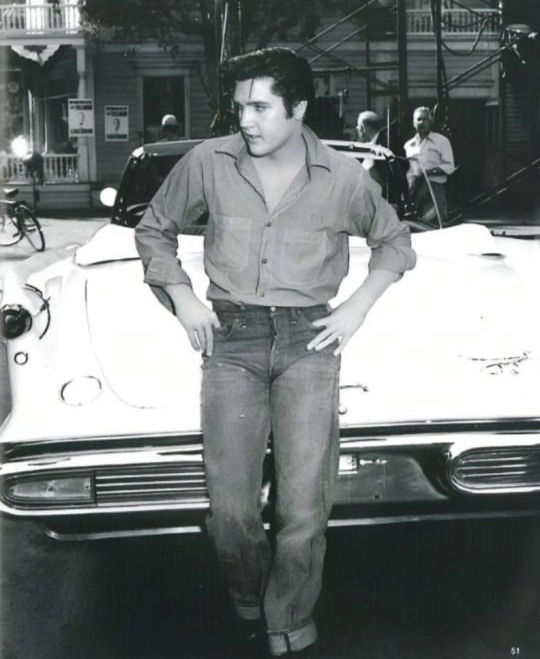
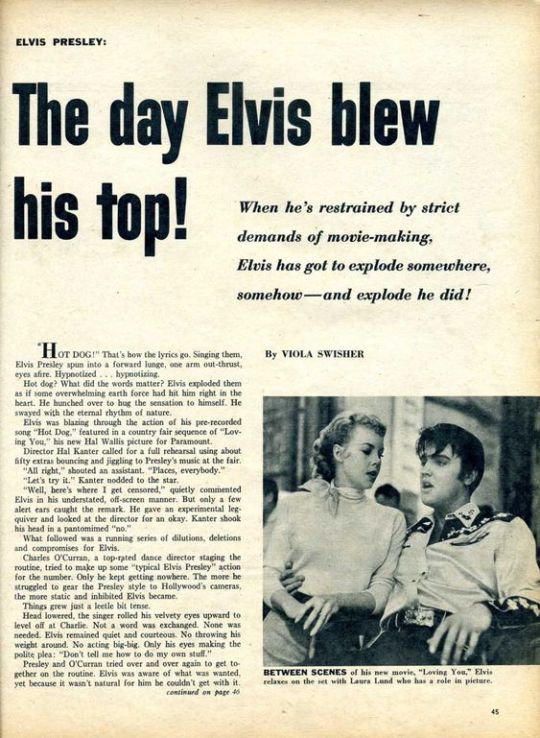
(1) Elvis' during filming of "Loving You" (Early 1957). (2) Page from article for the Silver Screen magazine (1957)
HERE'S A LITTLE BIT OF HOW IT WAS FILMING THE COUNTRY FAIR SEQUENCE FOR "LOVING YOU" — THE "HOT DOG" PERFORMANCE — ACCORDING TO A 1957 MAGAZINE ARTICLE:
THE DAY ELVIS BLEW HIS TOP! When he's restrained by strict demand of movie-making, Elvis has got to explode somewhere, somehow - and explode he did! By Viola Swisher "Hot Dog!" That's how the lyrics go. Singing them, Elvis Presley spun into a forward lunge, one arm out-thrust, eyes afire. Hypnotized... hypnotizing. Hot dog? What did the words matter? Elvis exploded them as if some overwhelming earth force had hit him right in the heart. He hunched over to hug the sensation to himself. He swayed with the eternal rhythm of nature. Elvis was blazing through the action of his pre-recorded song "Hot Dog," featured in a country fair sequence of "Loving You," his new Hal Wallis picture for Paramount. Director [and co-writer] Hal Kanter called for a full rehearsal using about fifty extras bouncing and juggling to Presley's music at the fair. "All right" shouted an assistant. "Places, everybody." "Let's try it," Kanter nodded to the star. "Well, here's where I get censored," quietly commented Elvis in his understated, off-screen manner. But only a few alert ears caught the remark. He gave an experimental leg-quiver and looked at the director for an okay. Kanter shook his head in a pantomimed "no". What followed was a running series of dilutions, deletions and compromises for Elvis. Charles O'Curran, a top-rated dance director staging the routine, tried to make up some "typical Elvis Presley" action for the number. Only he kept getting nowhere. The more he struggled to gear the Presley-style to Hollywood's cameras, the more static and inhibited Elvis became. Things grew just a litle bit tense. Head lowered, the singer rolled his velvety eyes upward to level off at Charlie. Not a word exchanges. None was needed. Elvis remained quiet and courteous. No throwing his weight around. No acting big-big. Only his eyes making the polite plea: "Don't tell me how to do my stuff." Presley and O'Curran tried over and over again to get together on the routine. Elvis was aware of what he wanted, yet because it wasn't natural for him he couldn't get with it.
Excerpt from article on the Silver Screen magazine (1957 issue) , pg. 45.
More was written in this article about the filming of "Loving You", possibly something more about how the filming of the scene went on until the final result but I, unfortunately, haven't found the following pages online. I guess the most important story was told by this excerpt anyways. They got the scene. We know they did. I wonder tho how Charles O'Curran had imagined the number. What we see Elvis doing onscreen while singing "Hot Dog" is more Elvis acting like himself or something like Charles wanted him to look like?
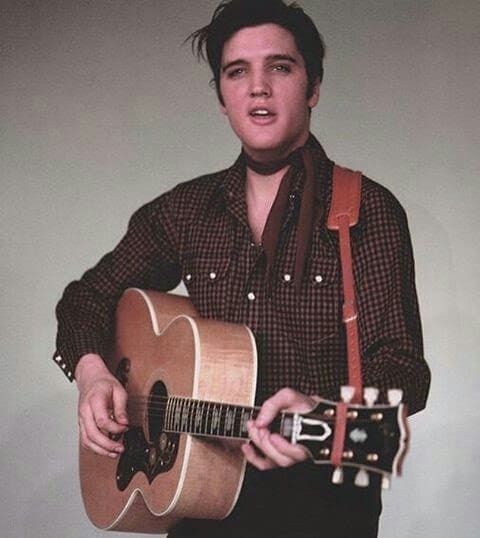
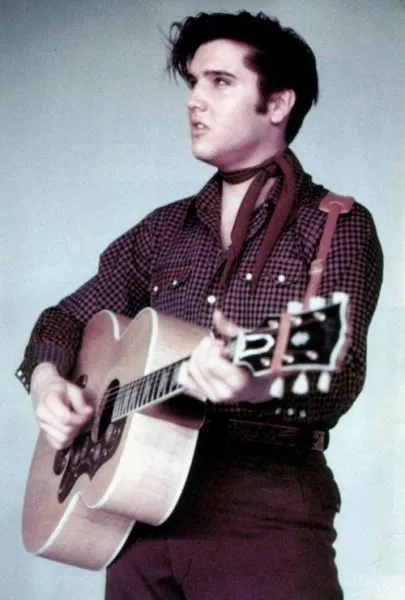
Pictures of the outfit Elvis wore to perform "Hot Dog" and, below, the King performing the song in scene featured in his second movie, "Loving You" (1957).
youtube
Scene from movie "Loving You" (Paramount Pictures 1957), starring Elvis Presley, Lizabeth Scott and Wendell Corey. Directed by Hal Kanter. Screenplay by Herbert Baker and Hal Kanter. Story by Mary Agnes Thompson. Produced by Hal B. Wallis.
"HOT DOG" — LYRICS
Hot dog, you say you're really coming back Hot dog, I'm waiting at the railway track Hot dog, you say you're coming home for good Hot dog, I'm going to keep knocking on wood And baby, I can hardly wait I'm gonna meet you at the gate, hot dog I fell in love with you and then you went away But now you're coming home to stay Hot dog, soon everything will be all right Hot dog, we're gonna have a ball tonight I've got a pocketful of dimes It's gonna be just like old times, hot dog You went away and every day was misery But now you're coming back to me Hot dog, my heart is gonna go insane Hot dog, when you come walking off the train Oh how lonely I have been But when that Santa Fe pulls in Hot dog, baby, baby, hot dog
Lyrics by Jerry Leiber/Mike Stoller
------------------------------------------------------------------------------------------------
FURTHER INFO - WHAT DOES 'HOT DOG' MEAN?
I'm not American, and that's why I don't get slangs in English right away (and that's also why you'll find typos in my writing, sorry 'bout that). So, until this very moment, I never understood why the song was entitled "Hot Dog". I found it so silly... I thought about the food, not gonna lie, but I just googled the word and, in slang, it seems 'hot dog' can mean someone who's dangerous, a daredevil or something. So, the poetic persona in the song is calling out the lady for leaving him for a while. I guess that's it. Probably many already got it from the start (and if I got it wrong, please, correct me) but this note is here just in case someone needs an explanation. Oh, I also found an article about the meanings of "hot dog" as a slang, over the years. It's really interesting. Like I say, Elvis is always directly or indirectly teaching me something. Read more about the meanings for 'hot dog' here: today.com/food/hot-dog-meanings.
--
UPDATE - May 22, 2024: @thetaoofzoe and @lookingforrainbows helped us with this one. THANK YOU SO MUCH, BABIES. ♥ According to dear @thetaoofzoe, "I'm under the impression that 'hot dog' here means he's expressing delight or excitement about the girl coming back. Like a 'yay! I'm so excited'" and then I read @lookingforrainbows with: "hot dog in this case might mean ‘I’m so excited’. It was a saying in the 50s to mean something like ‘wow! that’s awesome’" -- There you go, friends! Solved!
#elvis presley#elvis history#elvis movies#loving you#1957#elvis music#hot dog#elvis#elvis fandom#elvis fans#elvis the king#oh and... elvis is hot as fuck in loving you... just saying#Youtube
35 notes
·
View notes
Text

Tuesday, 12-03-24, 8am Pacific
'Mornin', everyone. Mr. Baggins here with our Morning Coffee Music, selections to get us in gear and in good cheer. Let's start this morning off with our daily three Preludes and Fugues played by Harpsichordist Malcolm Hamilton. Today we hear Preludes and Fugues Nos. 10, 11, and 12 from Book 2 of WTC.
youtube
youtube
youtube
Next, we hear another of the performances that Guiomar Novaes recorded in 1956, and was issued as side 2 of A Music Appreciation disc issued by The Book of the Month Club in 1957. This time she is playing Beethoven's Sonata No. 26 Op. 81a, in E flat major "Les Adieux". This is as definitive a performance of this piece as has ever been recorded. The poise, the grace and control in this are eye-opening, and yet it is as warm-hearted as anyone could make Beethoven be!
youtube
Next is a treat: a performance from March 21, earlier this year, by the UT Wind Symphony of Malcolm Arnold's "Four Scottish Dances", arranged for only winds by Paynter.
youtube
Next we hear the Philadelphia Orchestra, with Eugene Ormandy at the helm, in a performance of the piece Sergei Rachmaninoff dedicated to them, his Symphonic Dances, Op. 45, and the "Paganiniana" Op. 65, of Alfredo Casella. Another historic reference recording that has withstood the test of time!
We turn to the music of Schubert next, a very early recording featuring Sergei Rachmaninoff at the piano and Fritz Kreisler on violin, playing Schubert's Violin Sonata in A Major, D 574, in a historic recording from 1928, reissued on LP in several different incarnations.
youtube
Lovely, isn't it? The fact that we can hear these two in a performance that is nearly 100 years old is mind boggling. We even have Rachmaninoff playing his own concertos, all from 1925 to 1929! Let's jump ahead a few decades to the mid-late '50s and hear another of Chopin's Scherzos, played by Vladimir Horowitz, from his glory days in the 1950s at RCA. We hear the Scherzo No. 2 in B-flat Minor, Op. 31, recorded in 1957.
youtube
And I thought we might wrap today's Morning Coffee Music up with a couple of lovely songs, sung by Elisabeth Schwarzkopf, from her Carnegie Hall Recital of November 25, 1956. We hear Mozart's song "Abendempfindung", K. 523 and then Richard Strauss' "Wiegenlied" (Cradle Song), op. 41, nº 1. George Reeves is the Accompanist.
youtube
youtube
And with that gorgeous little melody still hanging in the air, we bring today's Morning Coffee Music to a close. I do hope you've enjoyed the selections this morning! Mr. Baggins signing off for now, but I'll return at 2pm Pacific with your Afternoon Stack of Classic Wax!
Until then, be kind, babies, be kind.
Baggins out.

9 notes
·
View notes
Text
Birthdays (bc I can)
I put my own fancasts and my headcannon b-day'
Euphemia Braithewaite-Potter - January 4, 1907
Walburga Irma-Black - April 17, 1907
Fleamont Potter - May 15, 1909
Charlus Potter (Monty' brother) - August 19, 1900
Lucretia Black (Orion' sister) - August 3, 1914
Orion Black - September 30, 1920
Druella Rosier (Axel' sister) - December 31, 1928
Axel Rosier (Rosier twins dad) - November 14, 1930
Cygnus Black (Black sisters dad) - July 30, 1938
Adele Jacob-Rosier (Rosier twins mom) - June 7, 1938
Alphard Black - June 26, 1925
Rodolphus Lestrange - October 19, 1952
Rabastan Lestrange- September 21, 1954
Lucius Malfoy - July 1, 1954
Enid Pettigrew (Peter' sister) - January 30, 1962
Mason McKinnon (Marlene' brother) - December 20, 1952
Mitchell McKinnon (Marlene' brother) - June 25, 1955
Matthew McKinnon (Marlene' brother) - November 7, 1958
Maxwell McKinnon (Marlene' brother) - February 29, 1962
Petunia Evans-Dursley - January 10, 1958
Mavan Rosier (Rosier twins brother) - March 14, 1965
Annabella Rosier (Rosier twins sister) - April 16, 1968
Elizabeth Meadows (Dorcas' sister) - May 1, 1965
Fabian Prewett - September 30, 1958
Gideon Prewett - September 30, 1958
Molly Prewett-Weasley - October 30, 1949
Billius Weasley (Arthur' brother) - May 26, 1952
Arthur Weasley - February 6, 1950
James Potter - March 27, 1960
Remus Lupin - March 10, 1960
Sirius Black - November 3, 1960
Peter Pettigrew - August 31, 1960
Lily Evans-Potter - January 30, 1960
Mary Macdonald - September 16, 1959
Marlene McKinnon - August 1, 1960
Dorcas Meadows - April 2, 1960
Bartemius Crouch Jr. - July 9, 1961
Evan Rosier - June 20, 1961
Pandora Rosier - June 20, 1961
Regulus Black - December 31, 1961
Alice Fortescue-Longbottom - August 14, 1960
Frank Longbottom - September 14, 1959
Ted Tonks - March 20, 1953
Emmeline Vance - July 18, 1957
Rita Skeeter - December 19, 1951
Ophelia Zabini - January 15, 1951
Emma Vanity - February 28, 1960
Andromeda Black - October 10, 1953
Narcissa Black - July 19, 1955
Bellatrix Black - May 2, 1991
Tom Riddle Jr. - February 19, 1979
Mattheo Riddle - January 20, 1980
Aliana Riddle - January 20, 1980
Mandy Lestrange - March 13, 1985
Cara Lestrange - May 23, 1986
Delphini Riddle - August 16, 1987
Lorenzo Berkshire - December 17, 1996
Nymphadora Tonks - October 8, 1973
Nina Tonks (Nymphadora' sister) - June 13, 1978
Lucas Rosier (Rosekiller child) - July 21, 1985
Nicholas Rosier (Rosekiller child) - July 1, 1987
Draco Malfoy - June 5, 1980
Lila Malfoy (Draco' sister) - June 5, 1980
Artemis McKinnon (Dorlene child) - September 13, 1981
Aries McKinnon (Dorlene child) - October 17, 1982
Jack McKinnon (Dorlene child) - January 23, 1987
Harry Potter - July 31, 1980
Lillian Potter (Harry' sister) - July 31, 1980
Rose Potter (Harry' sister) - May 24, 1981
Leo Potter (Harry' brother) - February 16, 1983
Pansy Parkinson - August 1, 1980
Blaise Zabini - November 1, 1980
Teddy Lupin - April 11, 1985
Neville Longbottom - July 30, 1980
Juliana Longbottom (Neville' sister) - October 15, 1986
Nicky Longbottom (Neville' brother) - October 15, 1986
Penelope Vance (Emmary child) - November 12, 1988
Hermione Granger - September 19, 1980
Violet Granger (Hermione' sister) - May 14, 1979
Bill Weasley - November 29, 1970
Charlie Weasley - December 12, 1972
Percy Weasley - August 22, 1976
Fred Weasley - April 1, 1978
George Weasley - April 1, 1978
Ron Weasley - March 1, 1980
Ginevra Weasley - August 11, 1981
Luna Lovegood - February 13, 1981
Eclipse Rosier (Pandalily child or Luna' sister) - January 11, 1985
32 notes
·
View notes
Text
A Family Running Out of Time…
By 1956, although it was kept a secret from the rest of the world, Gladys knew she was gravely ill. Elvis and Vernon also knew. Health was a very private matter during that era, and details of her deteriorating health were not shared publicly, or even openly discussed amongst family and friends. If we can see obvious outward signs of Elvis’ failing health in the 1970s, then we most certainly can see those of Gladys Presley from 1956 to 1958, as well.
At age forty-four, Gladys was referred to a cardiologist, Dr. Charles L. Clarke. It was Elvis himself who called the home of Dr. Clarke to establish the initial appointment. Elvis recognized that his mother was very ill. Many things have changed since 1956, but needing to see a cardiologist at such a young age was alarming then, just as it would be today.
By 1957, Elvis, Vernon and Gladys knew that her health was rapidly declining. Aside from potential denial, they had to know that their time together as a family unit might be cut short. The misnomer that Elvis’ fame, success or his draft noticed killed her is simply a romanticized, sensationalized notion.
The draft notice did not arrive until December 20, 1957. It was at least 18-months prior to that when Dr. Clarke was first called to consult on Gladys’ case. It was twelve months prior to the draft notice arriving that Gladys spent two weeks in the hospital. Elvis began filming Loving You on January 21, 1957. Vernon and Gladys were supposed to join him immediately, but the trip was delayed due to her failing health and extended hospital stay. Gladys was well enough to be a part of filming on February 21, 1957.
When Elvis was inducted to the United States Army one year later, her heart and liver problems were quite literally written all over her face. The dark circles under her eyes were outward signs that her liver was no longer able to properly clean her blood. Gladys’ confusion was an indicator that her liver was no longer properly removing toxins and her brain was quite literally becoming a toxic place. Her irrational fear of Elvis “going to war” is most likely the end result of that.
When the ambulance was called to Graceland at 11:30 a.m. on August 9th, there were many unknowns, as Gladys was admitted in grave condition, and noted to be suffering from an undiagnosed liver ailment. Dr. Clarke knew that time was short, and that Elvis needed to get home immediately. Elvis made it home in time to be with his mother before she passed.
Approximately six months after Elvis’ induction into the United States Army, Gladys would succumb to a then unknown genetic liver disease, Alpha-1 Antitrypsin Deficiency. That diagnosis would not be known in her lifetime or that of her doctor’s lifetime. It would not be known until the autopsy of Elvis Presley showed that he was a carrier of the inherited disease. The retelling of Gladys’ story would then be haunted for decades more by growing falsehoods of lifelong alcoholism until the consequences of the genetic liver disease were fully known, understood and pieced together.
In the video link below showing the family at the induction in March of 1957, the knowledge of upcoming change is visible on each of the faces of the tight-knit family of three. It had been them against the world from the moment Elvis was born. However, this video shows a matriarch who is gravely ill and each of them possessing some level of awareness that their time together would be fleeting.
Sally A. Hoedel
Author of Elvis: Destined to Die Young
https://www.youtube.com/clip/UgkxAHLfZY5NjPNP-779qcx0Ta2oDgRPnTxt
#elvis presley#elvis#elvis aaron presley#50s elvis#60s elvis#70s elvis#graceland#elvis elvispresley elvishistory gracleand. sallyhoedel destinedtodieyoung
20 notes
·
View notes
Text

This is a Norman Rockwell painting called Murder in Mississippi. It depicts the final moments in the lives of James Chaney, Andrew Goodman and Michael Schwerner, three civil rights workers killed by members of the Ku Klux Klan 58 years ago this June for registering people to vote. That's not ancient history. It's current events.
* * * *
LETTERS FROM AN AMERICAN
June 21, 2024
HEATHER COX RICHARDSON
JUN 22, 2024
Sixty years ago today, on June 21, 1964, twenty-year-old Andrew Goodman mailed a postcard to his parents in New York City. He had arrived in Meridian, Mississippi, the day before to work with Michael Schwerner, a 24-year-old former New York social worker, and James Chaney, a 21-year-old Black man from Meridian, to register Black voters in what became known as Freedom Summer.
“Dear Mom and Dad,” Goodman wrote. “I have arrived safely in Meridian Mississippi. This is a wonderful town and the weather is fine. I wish you were here. The people in this city are wonderful and our reception was very good. All my love, Andy.”
Mississippi had become a focal point for voter registration because fewer than 7% of Black Mississippians were registered, but members of the local chapter of the Ku Klux Klan, dedicated to preserving segregation and to keeping Black people from voting, intended to stop the people challenging their power. They had come to loathe Schwerner— like Goodman, a Jewish man— who along with his wife, Rita, had taken over the field office of the Congress of Racial Equality (CORE) in Meridian and had begun grassroots organizing.
At meetings, Ku Klux Klan members routinely talked about killing Schwerner, but without authorization from the Klan’s state leader, Sam Bowers, they held off. Several weeks before Goodman arrived in Mississippi, they got that authorization.
On June 21, Schwerner, Chaney, and Goodman set out to investigate the recent burning of a church whose leaders had agreed to participate in voter registration, an arson that, unbeknownst to them, was committed by the same Klan members who had received authorization to kill Schwerner.
After the three men left the burned church, Deputy Sheriff Cecil Ray Price stopped their car, arrested Schwerner for speeding, and held Chaney and Goodman under suspicion that they were the ones who had burned the church. Once night had dropped, after they paid the speeding ticket and left the Philadelphia, Mississippi, jail, Price followed them, stopped them, ordered them into his car, and then took them down a deserted road and turned them over to two carloads of his fellow terrorists. They beat the men, murdered them, and buried them in an earthen dam that was under construction.
Aside from the murderers, no one knew where the three men had gone. Their fellow CORE workers had begun calling jails and police stations as soon as they didn’t turn up according to schedule, but no one told them where the men were. By June 22 the men’s friends had gotten FBI agents from New Orleans to join the search. On June 23 the agents found the station wagon the men had been driving, still smoldering from an attempt to burn it.
As the agents searched—turning up 8 murdered Black men, but not the three they were looking for— President Lyndon B. Johnson, who as Senate majority leader had wrestled the Civil Rights Act of 1957 through Congress and who had pushed hard for a stronger civil rights law since becoming president in November 1963, harnessed the growing outrage over the missing men.
The House had passed a civil rights bill in February 1964, but southern segregationist Democrats in the Senate filibustered it from March until June 18, when news stations covered the story of hotel owner James Brock pouring acid into a whites-only swimming pool at the Monson Motor Lodge in St. Augustine, Florida, after Black and white people jumped into the water together. The water diluted the acid and the swimmers were not injured, but law enforcement arrested them. Seeing a white man pour acid into a swimming pool to drive out Black people created such outrage that senators abandoned their opposition to the measure.
On June 19, Republican Everett Dirksen (R-IL), the Senate minority leader, managed to deliver enough Republican votes to Majority Leader Mike Mansfield (D-MT) to break the filibuster. The Senate passed the bill and sent their version back to the House. Johnson used the popular rage over the three missing voting rights workers to pressure the House to pass the bill, and it did.
Johnson signed the Civil Rights Act of 1964 into law on July 2.
Just before he wrote his name, Johnson addressed the American people on television. Tying the new law to the upcoming anniversary of the Declaration of Independence, he noted that “those who founded our country knew that freedom would be secure only if each generation fought to renew and enlarge its meaning…. Americans of every race and color have died in battle to protect our freedom. Americans of every race and color have worked to build a nation of widening opportunities. Now our generation of Americans has been called on to continue the unending search for justice within our own borders.”
Johnson celebrated that the bill had bipartisan support of more than two thirds of the lawmakers in Congress and that it enjoyed the support of “the great majority of the American people.” “[M]ost Americans are law-abiding citizens who want to do what is right,” he said. “My fellow citizens, we have come now to a time of testing. We must not fail.”
Those opposed to Black equality saw the passage of the Civil Rights Act as a call to arms. On July 16, two weeks after Johnson signed the bill and a little more than three weeks after Chaney, Goodman, and Schwerner disappeared and while they were still missing, Arizona senator Barry Goldwater strode across the stage at the Republican National Convention to accept the party’s nomination for president. To thunderous applause, he told delegates that “extremism in the defense of liberty is no vice. And…moderation in the pursuit of justice is no virtue.” The votes of the delegates from South Carolina, the state that launched the Civil War in defense of American slavery, were the ones that put his nomination over the top.
On August 4 the bodies of the missing men were found in the dam near Philadelphia, Mississippi.
It turned out that Deputy Sheriff Price, who had arrested Schwerner, Chaney, and Goodman, and his boss, Sheriff Lawrence A. Rainey, were members of the Ku Klux Klan. Price had alerted his fellow Klansman Edgar Ray Killen that he had the three men in custody, and Killen called the local Klan together to attack the men when they got out of jail. Then Price dropped the three civil rights workers into their hands.
While the state of Mississippi would not prosecute, claiming insufficient evidence, in January 1965 a federal grand jury indicted 18 men for their participation in the murders. The Ku Klux Klan members, who were accustomed to running their states as they saw fit, did not believe they would be punished. An infamous photograph caught Price and Rainey laughing during a hearing after their federal arraignment on charges of conspiracy and violating the civil rights of the murdered men.
Ultimately, a jury found seven of the defendants guilty. Killen walked free because in addition to being a Klan leader, he was also a Baptist minister, and a member of the jury would not convict a minister. Price was convicted and sentenced to six years in prison (he served four). Rainey, who was not at the murder scene, was found not guilty, but he lost his job and his marriage and blamed the FBI and the media for ruining his life.
Voters in the 1964 election backed Johnson’s vision of the country, rejecting Goldwater by a landslide. Ominously, though, Goldwater won his own state of Arizona and five states of the Deep South—Louisiana, Mississippi, Alabama, Georgia, and South Carolina. The Republican Party had begun to court the segregationist southern Democrats.
In 1980, Republican presidential candidate Ronald Reagan spoke in Philadelphia, Mississippi, on August 3, sixteen years almost to the day after the bodies of the three men had been found.
“I believe in states' rights,” he said. “I believe in people doing as much as they can for themselves at the community level and at the private level. And I believe that we've distorted the balance of our government today by giving powers that were never intended in the constitution to that federal establishment. And if I do get the job I'm looking for, I'm going to devote myself to trying to reorder those priorities and to restore to the states and local communities those functions which properly belong there.”
In January 2004 a multiracial group of citizens who wanted justice for the 1964 murders met with Mississippi state attorney general Jim Hood and local district attorney Mark Duncan, as well as with Andrew Goodman's mother Carolyn Goodman and brother David Goodman, to ask Hood to reopen the case. In January 2005 a grand jury indicted Killen, who had organized the Klan to go after Chaney, Schwerner, and Goodman, for their murder.
On June 21, 2005, a jury found the 80-year-old Killen guilty of manslaughter.
He died in prison six years ago.
LETTERS FROM AN AMERICAN
HEATHER COX RICHARDSON
#history#the South#Mississippi#Civil Rights#the KKK#Ku Klux Klan#murder#race#racism#voting rights#civil rights#Lyndon Johnson
15 notes
·
View notes
Text
🗓️Creepypasta Date of Birth Headcanons:
+ their ages in my au - set in late 2000 - early 2001

Jeff the Killer: 2nd June, 1974 (26 years old)
Homicidal Lou: 23rd November, 1970 (30 years old)
Jane the Killer: 5th April, 1972 (28 years old)
BEN: 9th February 1987 - d. 26th April, 2000 (13 years old)
Eyeless Jack: 13th December, 1969 (31 years old)
Nina the Killer: 30th March, 1979 (21 years old)
Laughing Jack: 25th December, 1862 (no specific age)
Laughing Jill: 25th December 1859 (no specific age)
Isaac Clement: 3rd December, 1854 - d. 3rd December, 1893 (39 years old)
Will Clement: 28th August, 1977 (23 years old)
Frank the Undead: 27th April, 1896 - d. 31st January, 1931 (34 years old)
Jason the Toymaker: 15th November, 1746 - d(?). 21st May, 1779 (32 years old)
Sally Williams: 7th September, 1963 - d. 19th July, 1971 (8 years old)
Toby: 28th April 1975 (25 years old)
Clockwork: 21st October, 1977 (23 years old)
Bloody Painter: 1st October, 1968 (32 years old)
Judge Angels: 29th September, 1964 (36 years old)
The Puppeteer: 18th July, 1973 - d. 29th December, 1992 (19 years old)
Zero: 10th May, 1980 (20 years old)
Nurse Ann: 9th January, 1957 - d. 16th February, 1984 (27 years old)
The Dollmaker: 22nd December 1968 (32 years old)
Kagekao: August 4th, 1979 (21 years old)
Candy Pop: c. Early 1400s (no specific age)
Slenderman: Unknown (no specific age)
Zalgo: 1000BC (no specific age)
#creepypasta#jeff the killer#homicidal liu#jane the killer#ben drowned#eyeless jack#nina the killer#laughing jack#laughing jill#will grossman#isaac grossman#frankie the undead#jason the toymaker#sally williams#ticci toby#clockwork#bloody painter#judge angels#the puppeteer#zero creepypasta#nurse ann#the dollmaker#kagekao#candy pop#slenderman#zalgo#creepypasta headcanon#creepypasta headcannons#creepypasta fandom
45 notes
·
View notes
Text
Birthdays

My take on the birthdays of the characters of Hogwarts Mystery, original and canon characters without explicit birthdays.
Inner Circle
Rowan Khanna - 14 February 1973
Penny Haywood - 20 June 1973
Jae Kim - 28 March 1973
Talbott Winger - 8 July 1973
Barnaby Lee - 18 December 1972
Ben Copper - 5 September 1972

Outer Circle
Nymphadora Tonks - 8 April 1973, 05.45
Tulip Karasu - 8 April 1973, 19.20
Andre Egwu - 20 January 1973
Badeea Ali - 10 December 1972
Chiara Lobosca - 21 April 1973
Liz Tuttle - 15 September 1972
Alana Alves - 2 February 1973

Quidditch
Orion Amari - 21 February 1971
Skye Parkin - 23 May 1972
Murphy McNully - 25 July 1973
Erika Rath - 17 March 1972

Complicated
Diego Caplan - 30 June 1973
Corey Hayden - 20 October 1972
Victor Ketsueki - 15 November 1972
Merula Snyde - 30 December 1972
Ismelda Murk - 22 May 1973
Beatrice Haywood - 1 August 1977
Cedric Diggory - 17 October 1977
W. Levi - 18 November 1972
Patricia Rakepick - 6 December 1957

Jacob Marcovitz - 4 May 1967
Olivia Green - 19 January 1967
Duncan Ashe - 2 November 1966
10 notes
·
View notes
Text

DELEGATE OF THE DAY - Jayantha Dhanapala
from Mount Vernon Argus, March 21, 1957
#delegate of the day#jayantha dhanapala#ceylon#1957#mount vernon argus#*pictures#htyfnetwork#new york herald tribune world youth forum#herald tribune world youth forum#the world we want#1950s#vintage#newspaper
2 notes
·
View notes
Text


First of the ladies, the Gatekeeping Girlboss herself, Dahlia Lind.
Here's some basic info! <3 Goes By: BeeDee Nicknames: Black Dahlia, BD, BeeDee DOB: March 13th, 1957 Age: 21 (until her B-Day) Gender: Female (she/her) Sexuality: Bi/Pan Ethnicity: Swedish Occupation: Student (Cosmetology Major), Two Possible side-jobs, Head of the Cheer Squad Socioeconomic Status: Rich. Family owns a massive clothing retail company. Place of Birth: Stockholm, Sweden Family: No siblings, Divorced Mother and Father (Daddy's Girl, for sure) Height: 6'1“ Weight: 155 lbs. Disabilities: None (?) Fashion Style: Rich/Preppy/With the Current Fashion Coordination (or lack thereof): Very coordinated, and aware. Someone could throw something from across the room and give her a 2 seconds heads up, and she'd catch it without a problem. Personality Type/Trait: Executive - Unsurpassed at managing things, or people, controlling, attention-seeking Introvert/Extrovert: Extroverted, and will force others to be only if it gets her more attention Self-Esteem: Very High, thinks she's above everyone else and only expects the best Hobbies: Seeing how far she can push people to do things for her, doing her nails and trying new types of makeup and looks, shopping, cheer leading Skills/Talents: Fairly strong, probably 3rd strongest out of the Main 8, very good at manipulation, great dancer, Good Leadership, talented gardener Loves: Clothes, Makeup, Cheer, Pop Music and some Disco, Cosmo-Type Magazines, Flowers Phobias/Fears: Things she can't control, someone becoming more popular then her, ending up with no friends, doing something embarrassing and having everyone laugh at her, Bad Hair Days Angered By: No one listening to her, not having enough attention on her, people not living up to her expectations/failure from others Pet Peeves: Loud Rock/Punk Music, untidiness, people who don't put effort into their appearance Obsessed With: Fashion, Makeup, Good Looking people she deems worth of her attention Bad Habits: Preens a lot, always has to have a pocket mirror on her to fix things if need be checking it often, not caring/listening to things that are important, always has to have her way Desires: To Become a successful model, or the worlds best beautician, have everyone love her and give her attention Flaws: Easily Angered, Ignorant, Self-Important, Selfish, Mean Secrets: Tries her best to hid how unhinged she actually is, out of everyone she'd be most likely to get away with murder. Is actually really sad most of the time, but masks her real feelings with her ego. Really needs a hug. Regrets: Not being able to fully express herself. Being mean to Patty the first time the met, and can't bring herself to apologize or really fix things between them because of her ego. Accomplishments: 8 time Beauty Pageant winner, great garden with flowers that have won at least 2 awards, Cheer Squad Leader Languages Known: Fluent in Swedish, and English, knows a bit of Gaelic (from Patty as her roommate)
(Things are subject to change the more I get things fine tuned, I've also kept some things secret for the time being. - Crow <3)
Bonus! Basic Profile Sheet, for funsies! X

#Project 78#BeeDee#character concept#obligatory mean girl type but i have ideas for her to make her seem less...bitchy? i guess
5 notes
·
View notes
Text

Footnotes, 101-150
[101] Joost A. M. Meerloo, Mental Seduction and Menticide: The Psychology of Thought Control and Brain-Washing (London: Jonathan Cape, 1957), 163–164, 184.
[102] B. A. Robinson, “Promise Keepers, Pro and Con: Part 1,” Ontario Consultants on Religious Tolerance, November 2, 2003, www.religioustolerance.org.
[103] Jena Recer, “Whose Promise Are They Keeping?” National NOW Times, August 1995, www.now.org.
[104] James Dobson, “Building Moral Character in Kids,” radio broadcast, Focus on the Family International, February 8, 2006, www.oneplace.com =2/8/2006.
[105] Tony Kushner, Angels in America (New York: Theatre Communications Group, 1995), 46.
[106] James Dobson, Marriage under Fire: Why We Must Win This Battle (Sisters, OR: Multnomah, 2004), 41.
[107] “Focus on the Family,” Citizen Magazine January 2003, quoted in Jeff Lutes, A False Focus on My Family (Lynchburg, VA: Soulforce, 2004), 8.
[108] Dobson, Marriage Under Fire, 49.
[109] James Dobson, Bringing Up Boys (Wheaton, IL: Tyndale House, 2001), 127.
[110] Robert Knight, “The Homosexual Agenda in Schools,” Family Research Council, quoted in Matthew Shepard, “Nazi Anti-Jewish Speech vs. Religious Right Anti-Gay Speech,” Hatecrime.org, www.hatecrime.org.
[111] P. Gibson, “Gay Males and Lesbian Youth Suicide,” in M. R. Feinleib, ed., Report of the Secretary’s Task Force on Youth Suicide, Volume 3: Prevention and Interventions in Youth Suicide(Rockville, MD: U.S. Department of Health and Human Services; Public Health Service; Alcohol, Drug Abuse, and Mental Health Administration, 1989; DHHS publication ADM 89–1623), 110.
[112] Pat Robertson, quoted in Richard K. Fenn, Dreams of Glory, 8.
[113] Kavan Peterson, “Washington Gay Marriage Ruling Looms,” Stateline.org, March 7, 2006, cms.stateline.org; “Same-Sex Marriage Measures on the 2004 Ballot,” National Conference of State Legislatures, November 2004, www.ncsl.org.
[114] Mel White, Stranger at the Gate (New York: Penguin, 1995), 25.
[115] Ibid., 22–23.
[116] Ibid., 29.
[117] Ibid., 14.
[118] Ibid., 49–50.
[119] Ibid., 96.
[120] Ibid., 107.
[121] Ibid., 142.
[122] Hannah Arendt, The Origins of Totalitarianism(New York: Harcourt, 1979), 353.
[123] Scott LaFee, “Local Scientists, Doctors and Professors Talk About ‘Intelligent Design,’” San Diego Union Tribune, June 8, 2005, F-1.
[124] Frank Newport, “Third of Americans Say Evidence Has Supported Darwin’s Evolution Theory,” Gallup Poll, November 19, 2004, poll.gallup.com.
[125] Keith Graham, Biology: God’s Living Creation (Pensacola, FL: A Beka, 1986), 404.
[126] Alfred M. Rehwinkel, The Wonders of Creation (Minneapolis, MN: Bethany House, 1974), in Graham, Biology, 133.
[127] Graham, Biology, 163.
[128] Graham, Biology, 351.
[129] Carl Wieland, “Darwin’s Bodysnatchers: New Horrors,” Creation 14:2 (March 1992), 16–18.
[130] Carl Wieland, “Apartheid and ‘The Cradle of Humankind,’” Creation 26:2 (March 2004), 10–14.
[131] “What Happened When Stalin Read Darwin?” Creation 10:4 (September 1998), 23.
[132] Jerry Bergman, “Darwinism and the Nazi Race Holocaust,” Technical Journal 13:2, 101–111.
[133] “Evolution and the Hutu-Tutsi Slayings,” Creation 21:2 (March 1999), 47.
[134] Graham, Biology, 347.
[135] Jerry Bergman, “Was Charles Darwin Psychotic? A Study of His Mental Health,” Impact (January 2004).
[136] Raymond Hall, “Darwin’s Impact—The Bloodstained Legacy of Evolution,” Creation 27:2 (March 2005), 46–47.
[137] Graham, Biology, 347.
[138] Ibid., 349.
[139] Hannah Arendt, Origins of Totalitarianism, 371.
[140] “Intelligence Report,” Southern Poverty Law Center (Spring 2005), 4. www.splcenter.org.
[141] Union of Concerned Scientists, “Scientific Integrity in Policy Making: An Investigation into the Bush Administration’s Misuse of Science,” March 2004, 2; 32, www.ucsusa.org.
[142] This lecture was taped and transcribed by Timothy Nunan of Princeton University.
[143] Karl Popper, The Open Society and Its Enemies (Princeton: Princeton University Press, 1971), 1:96.
[144] Max Blumenthal, “Justice Sunday Preachers,” The Nation, May 9, 2005 (Web edition only), www.thenation.com.
[145] Ibid.
[146] Ibid.
[147] David Kirkpatrick, “Club of the Most Powerful Gathers in Strictest Privacy,” The New York Times, August 28, 2004.
[148] Ibid.
[149] Max Blumenthal, “Who Are Justice Sunday’s Ministers of Ministry?” Talk To Action, January 6, 2006, www.talk2action.org.
[150] Quoted in Daniel Lev, The Terrorist Next Door (New York: Thomas Dumae/St. Martin, 2002), 27.
#christianity#fascism#right-wing#us politics#xtians#United States of America#christians#anarchism#anarchy#anarchist society#practical anarchy#practical anarchism#resistance#autonomy#revolution#communism#anti capitalist#anti capitalism#late stage capitalism#daily posts#libraries#leftism#social issues#anarchy works#anarchist library#survival#freedom
5 notes
·
View notes
Photo

TV Guide - August 15 - 21, 1964
The “Wagon Train” Regulars
John Herrick McIntire (June 27, 1907 – January 30, 1991) Film and television character actor who appeared in 65 theatrical films and many more television series. McIntire is well known for having replaced Ward Bond, upon Bond’s sudden death in November 1960, as the star of NBC’s Wagon Train. He played Christopher Hale, the leader of the wagon train (and successor to Bond’s character, Seth Adams) from early 1961 to the series’ end in 1965. He also replaced Charles Bickford, upon Bickford’s death in 1967, as ranch owner Clay Grainger (brother of Bickford’s character) on NBC’s The Virginian for four seasons. (Wikipedia)
Robert Fuller (born Leonard Leroy “Buddy” Lee, July 29, 1933) Horse rancher and retired actor. He began his career on television, guest-starring primarily on Western programs, while appearing in several movies. In his five decades of television, Fuller was known for his deep, raspy voice and was familiar to television viewers throughout the 1960s and 1970s from his co-starring roles as Jess Harper and Cooper Smith on the popular 1960s Western series Laramie and Wagon Train, and was also well known for his starring role as Dr. Kelly Brackett in the 1970s medical /action drama Emergency! (Wikipedia)
Benjamin Franklin "Frank" McGrath (February 2, 1903 – May 13, 1967) Television and film actor and stunt performer who played the comical, optimistic cook with the white beard, Charlie B. Wooster, on the western series Wagon Train for five seasons on NBC and then three seasons on ABC. McGrath appeared in all 272 episodes in the eight seasons of the series, which had ended its run only two years before his death. McGrath's Wooster character hence provided the meals and companionship for both fictional trail masters, Ward Bond as Seth Adams and John McIntire as Christopher "Chris" Hale.
After Wagon Train, McGrath appeared in 1965 and 1966 as Uncle Lucius in nine episodes of ABC's situation comedy Tammy, with Debbie Watson in the title role and Denver Pyle as the grandfather. Thereafter, McGrath was a guest star on two network westerns, as stagecoach driver Neddie Henshaw on the 1966 episode "Linda" of NBC's The Virginian and as Buster in the 03/13/1967 episode "Plunder", of ABC's The Big Valley. (Wikipedia)
Terry W. Wilson (September 3, 1923 – March 30, 1999) Actor most noted for his role as "Bill Hawks", the assistant trail master, in all 267 episodes of the NBC and ABC western television series, Wagon Train, which aired from 1957 to 1965.
Wilson appeared in more than thirty-five films and television programs between 1948 and 1981. Many of his early roles were uncredited. On July 2, 1953, he was cast as a stagecoach guard in episode 121, "Woman from Omaha", of The Lone Ranger. In 1956, he had another uncredited role as a robber in the ABC/Warner Brothers western series, Cheyenne, the first television western in an hour-long format, starring Clint Walker.
After Wagon Train, Wilson appeared in several other westerns, including ABC's short-lived Custer and Hondo in 1967, in four episodes of NBC's The Virginian/The Men from Shiloh starring James Drury in 1970 and 1971, once on CBS's Gunsmoke in 1972, twice in Richard Boone's Hec Ramsey in 1973 and 1974, and as Judge Lennon in the episode "Counterall" of Buddy Ebsen's CBS detective series, Barnaby Jones. (Wikipedia)
5 notes
·
View notes
Text
[FAN STORY] "Those five or six minutes that will stay in my heart forever" — Excerpt: "ELVIS: Live at the International" by Kieran Davis (2011)


February 18, 1970: Elvis backstage with fan, Judy Cherry. Judy is an England "super fan" of Elvis, who met him in 1970, at the International Hotel in Las Vegas, NV.
Here's Judy's recollections of that moment:
"... The first thing I said when he came out was just a whispered 'Elvis!' He put his arms around me and gave me a nice warm hug. I told him I had waited fourteen years for this and he said 'Have you? That's a long time to wait, isn't it honey?' Then gave Jamie (the girl with me) a nice hug and said, 'Did you come all the way from England?' She said, 'Yes' He said, 'Thank you, hon.'
I said, 'Elvis, do you have time for a couple of pictures?' His answer was a warm, 'Sure.' So while Jamie was getting my camera out, I showed him a copy of the Elvis Presley story, that I had brought with me, and told him I had had it since 1957. He seemed genuinely amazed. He came across this one real old picture and said, 'This really is old, man. I was 21 years old here!'
Note: Possibly, Judy is refereeing to a magazine called "ELVIS PRESLEY: THE INTIMATE STORY MAGAZINE" (Published in 1957)
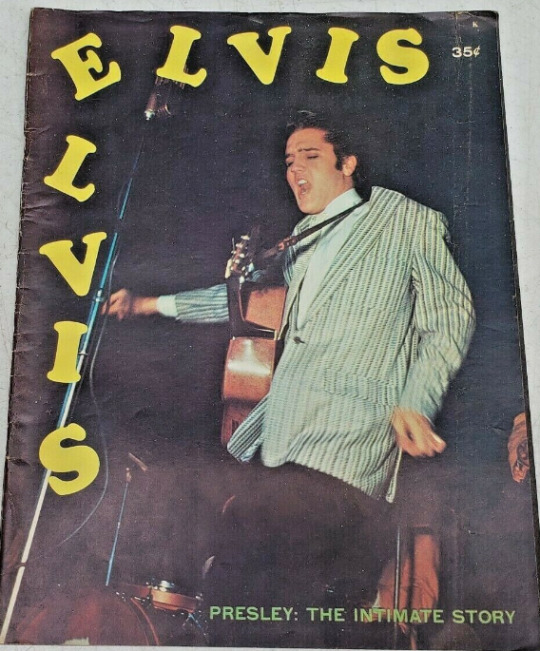


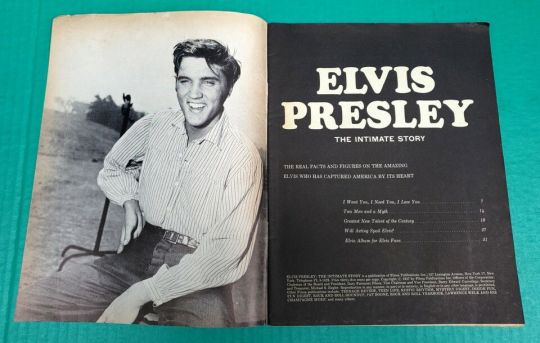

IMPORTANT UPDATE -- March 2024: I won't erase what I published orignally because there are friends who reblogged it already and I feel this can look confusing, but one minor correction is needed. This magazine above is definitely NOT the one Judy Cherry was holding for Elvis to sign. @whositmcwhatsit posted the actual book on her blog which is "The Elvis Presley Story edited by James Gregory, introduction by Dick Clark". I apologize for the wrong assumption I made, friends. I had never saw the actual book cover (until now), thus when researching the name "the Elvis Presley story", as Judy mentioned in her recollection, it only got me to think the magazine I shared on my original post [the one above] could be a the one she was referring to. My bad. Well, it's corrected thanks to our wonderful Jade. ♥ I hope you don't mind, dear, if I use the picture of your copy to illustrate this post.
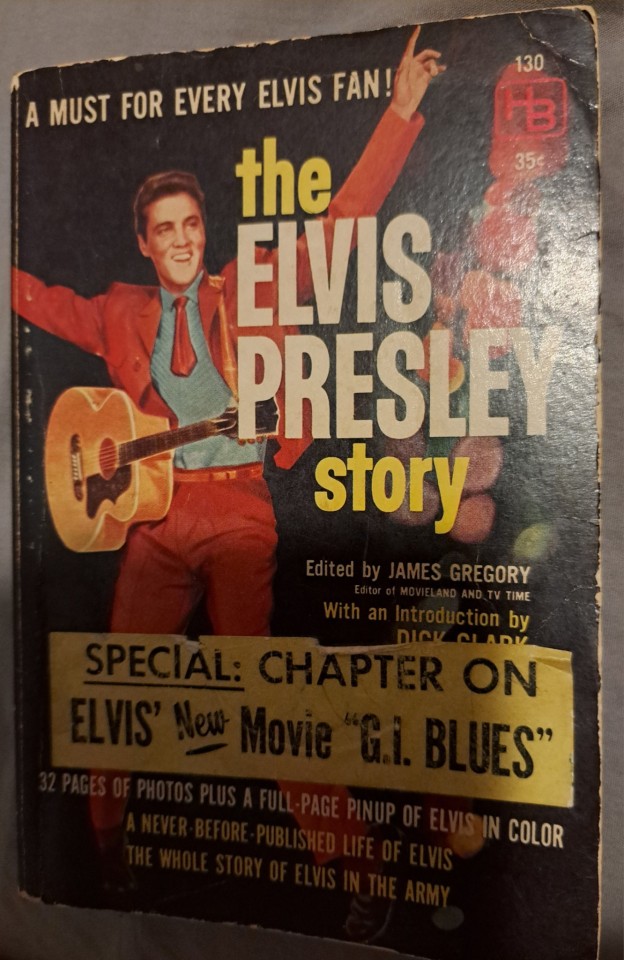
Photo by the copy our friend Jade [@whositmcwhatsit] bought. Lucky girl! Precious!🥹🩷
[Continuing the story...]
"In between these dribbles of conversation we had taken one picture (shown at the beginning of this post), had some trouble with the flashcube and now we're taking another picture... then he turned to Jamie and said, 'Now we are gonna get one with you, aren't we honey?' I got the picture, he said goodbye to Jamie and came over and gave me a hug. I said, 'Goodbye, Elvis, I'll see you tomorrow night... whether you see me or not: cause I'll be going to the show every night for the rest of the time.' He seemed really surprised at this and said 'Eleven times! Thank you so much, sweetheart. I just wish I could meet everyone of you!'
"He kissed me goodbye and he was gone but the 5 or 6 minutes will stay in my heart forever."
♥
One of the things I love the most about EP (and what turned me into a passionate fan of his) is how loving he was with his fans, he really listened to them. He treated them like people, not numbers or simply "admirers". He cared about giving them the time of their lives once they were there to watch him performing or even if they were just around to ask for his autograph or pictures. Elvis was truly genuine when interacting with them — actually this word "genuine" is used by many of the fortunate fans who got to meet and talk to him, to describe EP's interactions with them.
He cared so much about his fans that it's said he could remember the frequent ones by their names, all of them, the die hard fans, and even asked about some of them to his other fans whenever they were uncommonly not around for a few days (specifically talking about the fans that hanged around at his homes gates now).
EP was a great guy. He deserved all the success he conquered. The best performer ever! It's always said the good ones are always taken from us too soon. Well, that seems to be the truth, tragically. How we wish we could see and talk to him today, having such great memories like Judy's, while EP would be at his 88 year-young of a well-lived life. Imagine the conversations with this guy! The stories he could share with us. Anyway, we'll forever cherish you, EP.⚡♥
#elvis presley#elvis the king#elvis fans#elvis#elvis fandom#elvis history#70s elvis#elvis was so attentive
103 notes
·
View notes